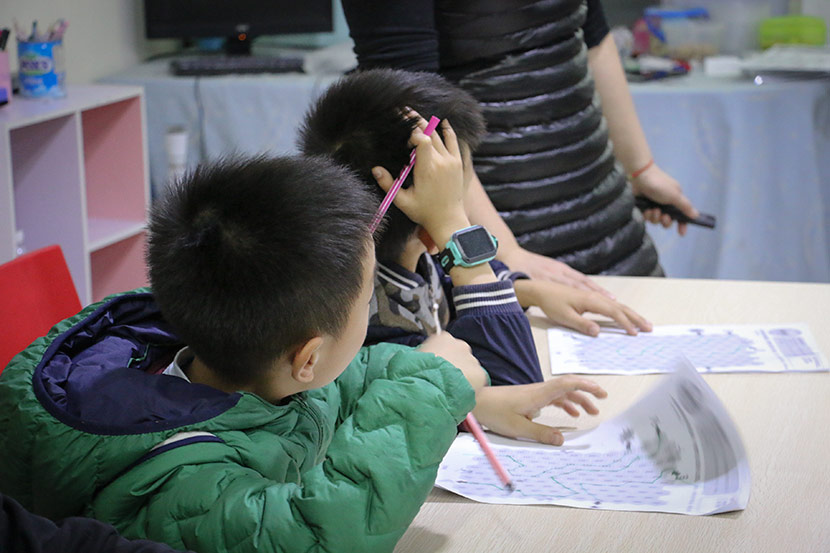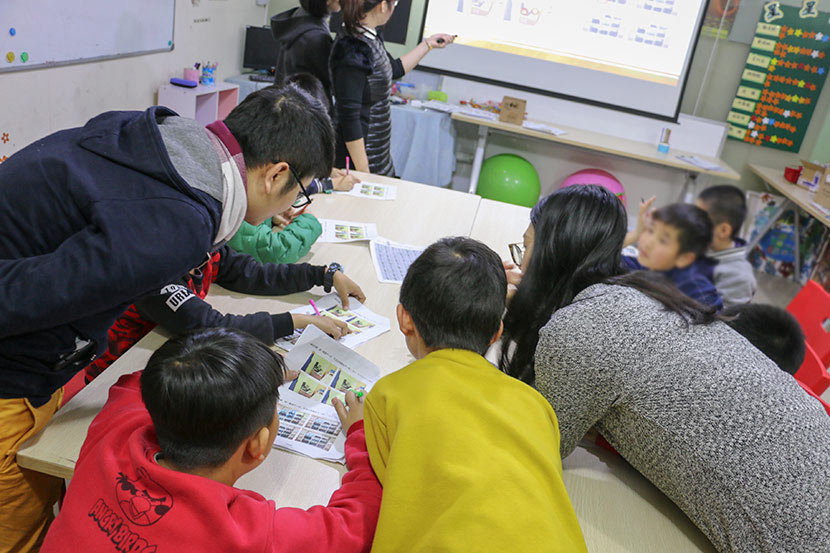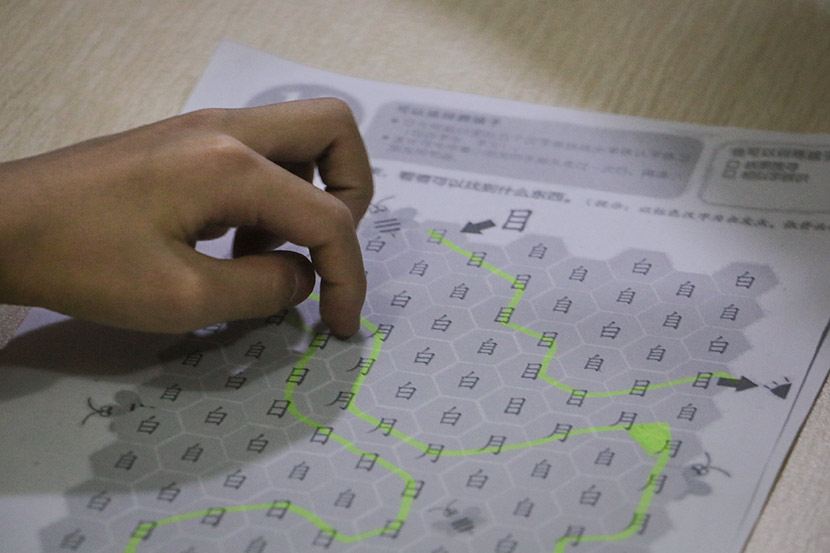GUANGDONG, South China — In a classroom at Weining Dyslexia Education Center, several kids around 10 years old excitedly grab colored pens and begin highlighting patterns in a series of Chinese characters. The exercise is one of many designed to help the children overcome dyslexia. Inside the classroom, they are surrounded by peers who struggle with the same disorder, but outside, they are often seen as bad students and called “stupid” or “lazy” by teachers.
The need for recognition of the learning disability in China is pressing: An estimated 11 percent of the country’s primary school students have dyslexia, a total of about 10 million children, according to research published in 2016 by the Chinese Academy of Sciences. Despite this staggering number, there is little understanding of and barely any support for dyslexic students on the Chinese mainland — the Weining center, located in southern tech hub Shenzhen, is one of few organizations dedicated to the cause. Dyslexia is well-known and well-researched in many Western countries, but awareness of the disability remains low across the Chinese mainland; without support, those affected are unable to compete in school, stifling their future potential.
Su Yingzi knows this all too well. Her son, 11-year-old Xiaogu, is clever and witty in many ways. He excels at devising new games, cracking jokes comes naturally to him, and he makes friends easily. However, reading and writing Chinese characters seemed an insurmountable obstacle. While some of his classmates needed less than half an hour to memorize a few characters, Xiaogu could spend hours on the task and still forget how to write the words. When it came to exams, he often failed to understand the questions because many characters simply did not make sense to him.
In hindsight, Su believes her son showed early signs of the disability in kindergarten: His handwriting was messy, and he was often the last to finish writing exercises. “But the teacher attributed his performance to laziness, and I believed it, too,” Su said.
When Xiaogu entered primary school, Su spent thousands of yuan to send him to a cram school, but the family saw little improvement. Su started to lose patience. She scolded Xiaogu for his disappointing exam scores and admits to beating him when he wrote characters incorrectly.
Xiaogu could not understand why he struggled so much in something his peers could easily master. His aversion to schoolwork grew. Eventually, he stopped trying altogether, submitting blank exam papers even though he could have answered some of the questions.

Children with dyslexia take a class at Weining Dyslexia Education Center in Shenzhen, Guangdong province, Jan. 30, 2018. Cai Yiwen/Sixth Tone
A turning point came before Xiaogu entered fourth grade. A social worker friend of Su’s suggested that Xiaogu might have dyslexia. Unfamiliar with the disability, Su looked it up online and had Xiaogu tested at Weining Dyslexia Education Center, the first NGO specializing in dyslexia on the Chinese mainland.
People with dyslexia have trouble both reading and writing. According to Tan Lihai, director of the Shenzhen Institute of Neuroscience, the disability is more difficult to overcome for children who learn to read and write in Chinese, a language with thousands of characters.
Words in alphabetic languages use a standard set of letters and are written the same way as they are pronounced, but a Chinese character contains little to no information about its corresponding sound. Some characters look similar but have very different pronunciations and definitions: For example, take 己 (ji), meaning “self,” and 已 (yi), meaning “already.” To learn Chinese, students must connect a character’s visual form, pronunciation, and meaning through rote memorization.

A GIF shows how dyslexic children often write Chinese characters: Some write one character as two, some add a stroke, and some mix up different parts of the character. Ding Yining and Liu Chang/Sixth Tone
In his research, Tan found that dyslexia among Chinese speakers is associated with parts of the brain that are crucial for visual perception, spatial relations, and cognitive skills — rather than parts that support letter-to-sound conversion, as is the case for alphabetic language speakers with dyslexia. As a result, some people have a hard time remembering the meaning of a character or phrase even if they can recognize and read it, some skip words when reading a sentence, some mix up different parts of the character, and some write one character as two. It often takes them much longer to complete lessons or exams compared with their peers — a factor that isn’t taken into consideration in most Chinese schools.
When Xiaogu was diagnosed, Su’s immediate response wasn’t relief that she finally knew what was going on, but anxiety over the future her son faced with a disability that is not recognized by the domestic education system. “I was disappointed when he was confirmed as having dyslexia,” Su said. “Why does my boy have to suffer this?”
“I was disappointed when he was confirmed as having dyslexia. Why does my boy have to suffer this?
- Su Yingzi, mother of a child with dyslexia”
Liang Yueyi, a teacher at Weining Dyslexia Education Center, told Sixth Tone that although awareness of dyslexia in the developed metropolis of Shenzhen is much higher than in most Chinese cities, community research showed that more than 75 percent of residents had never heard of the disability. When asked what the term referred to, some thought it described people without hands. Others had heard about dyslexia but thought it only affected people who use alphabetic languages.
For decades, researchers made the same mistake. Dyslexia has been studied in Europe since the late 19th century, but until the 1980s, experts believed it didn’t affect Chinese speakers, and the field didn’t gain much traction among researchers in China until the 1990s.
The four genes thought to cause dyslexia in alphabetic language speakers have not been confirmed as factors in Chinese dyslexia. Instead, scientists have found two other genes that could be related. Yet Chinese dyslexia research has a long way to go, and there is little financial support, said Tan.
The situation on the Chinese mainland is different from that of Hong Kong and Taiwan, which have passed laws and regulations regarding dyslexia. For example, in Hong Kong, the education bureau tests students’ learning abilities in first grade. Those diagnosed with dyslexia receive financial support as well as special assistance during class, including longer exam time and specially formatted test papers with larger characters. Students may also use computer programs to help read their exam questions and can seek support from a number of private language clinics and organizations. Some students with dyslexia have gone on to study at top universities — an achievement that most parents of mainland children with the disability find unthinkable.

Teachers and volunteers help dyslexic students with schoolwork at Weining Dyslexia Education Center in Shenzhen, Guangdong province, Jan. 30, 2018. Cai Yiwen/Sixth Tone
Meanwhile, there are no policies to support dyslexic children on the Chinese mainland. NGOs and social services for these students are extremely rare, even in prosperous cities with big education budgets like Shanghai. Areas in Guangdong province — near Hong Kong — are more advanced, but even here, there are fewer than 10 organizations that help dyslexic children, with the largest serving no more than a few hundred.
Since Weining Dyslexia Education Center opened in 2010, it has aimed to raise awareness about dyslexia and has partnered with local primary schools. Wang Lei, the center’s director, told Sixth Tone that in the absence of education policies for dyslexic students — including a standardized exam to test for dyslexia — convincing mainland schools and parents to recognize the disability is difficult. “Chinese dyslexics are a huge group of people who need help, but they are invisible because they seem so normal in daily life,” Wang said. Applying for extended test-taking time or specially formatted exam papers like in Hong Kong would only be possible with a policy or notice from the local education department.
Some parents also remain skeptical and refuse to accept that their children have a disability. “Even after their children are diagnosed with dyslexia at our center, some parents still cannot believe that reading and writing characters could be a problem,” Wang said, adding that he often points to the Hong Kong policies to help explain that Chinese dyslexia indeed exists.

A student highlights matching Chinese characters on a worksheet at Weining Dyslexia Education Center in Shenzhen, Guangdong province, Jan. 30, 2018. Cai Yiwen/Sixth Tone
Wang hopes to increase the center’s collaboration with researchers and schools, and to help collect data on the issue that could inform future policy recommendations.
Experts agree that it’s imperative to raise awareness of dyslexia and adopt policies to support those with the disability — not only because it affects the futures of millions of children, but also because the severity of the disability could increase as electronic devices continue to replace paper and ink. Researchers have found a negative correlation between the time students spend using electronics and the speed of development of reading and writing ability. Tan’s research has also found that using Pinyin — the official romanization system for Chinese on the mainland — to input text instead of writing characters by hand has had a negative impact on students’ reading ability.
“Even after their children are diagnosed with dyslexia at our center, some parents still cannot believe that reading and writing characters could be a problem.
- Wang Lei, Weining Dyslexia Education Center director”
A child who takes classes at the Weining center told Sixth Tone that he felt much happier there — his primary school teacher never praised or encouraged him, he said, but scolded him harshly when he did poorly in class. Cao Wenying, whose 11-year-old son has dyslexia, said that it had become a ritual in her son’s class for teachers to treat top students to pizza, resulting in anxiety and frustration for those who did not do well academically.
This treatment can negatively impact students’ self-esteem and lead to lasting psychological problems, according to Liang. She recalled seeing students who had grown so frustrated that they would bang their heads against the wall. “For some students, that’s the way they relieve negative emotions when they don’t receive understanding and care from the people they care about,” she said.
The biggest change for Cao’s son after attending the Weining center classes was not an improvement in test scores, but a transformation in attitude. He used to be quiet in class and had few friends. Yet once diagnosed, he wasn’t “the dumb kid” anymore, and he regained his confidence. Cao has also stopped pushing him to excel in reading and writing, and has started to read his favorite stories with him every night. “He is now much happier and more talkative than he used to be,” said Cao.
Su and her family have had a similar experience. Though she was shocked and disappointed when Xiaogu was first diagnosed with dyslexia, Su now spends at least half an hour each day helping him memorize characters with a method she learned from the Weining center. Su even convinced her son’s teacher to adjust the curriculum to make the classes more interactive and engaging. She says Xiaogu has since started participating much more actively in class, and his Chinese test scores are now average.

Dyslexic children play with ribbons to improve dexterity in a courtyard next to Weining Dyslexia Education Center in Shenzhen, Guangdong province, Jan. 30, 2018. Cai Yiwen/Sixth Tone
The biggest concern for parents of dyslexic students, however, is their children’s future. Many are worried that their kids won’t be able to succeed in the highly competitive and exam-oriented education system. As a university graduate who now works as an architect, Su always assumed that her son would also attend college. Now, she’s coming to grips with a future in which her son might have to take an entirely different path. “Even vocational schools in Shenzhen are not easy to get into,” Su said.
Xiaogu’s optimistic attitude and friendly demeanor, she hopes, could be his saving grace.
“We used to think test scores were the most important thing,” Su said. “But really, how does getting all the correct answers on an exam benefit you in the future? Most of the knowledge we gain comes from real life, not from books. Now I believe that he can still go far with his personality.”
Editor: Denise Hruby.
(Header image: An educator teaches a lesson to students with dyslexia at Weining Dyslexia Education Center in Shenzhen, Guangdong province, Jan. 30, 2018. Cai Yiwen/Sixth Tone)




